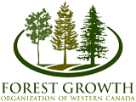Why invest in Growth and Yield?
Forest management planning and associated estate modeling is only as good as the basic inventories, assumptions and estimates that contributed to plan development. Yield estimates and growth assumptions are foundational to forest management planning and determination of sustainable harvest levels.
Experienced silviculturists have a good understanding of the trade‐offs between up‐front silviculture investment and tree growth, but these relationships have, for the most part, not been quantified. The justification for silvicultural investment and the ability to assess risk would be strengthened by quantifying the impacts of treatments. Although, widely accepted practices for quantifying current yields are in place, rapid advancements in technology present us with opportunities to get more reliable estimates more efficiently. Tools to do this need to be easy to use.
Forest growth is complex. It is influenced by site, stand composition, anthropogenic treatments, etc. Extensive work has been done in advancing our understanding and creating tools to help us estimate forest growth. Given the complexity of the systems we are trying to model, advancements tend to demand significant amounts of data.
Because forests in western Canada grow slowly, the data that is of most interest is long‐term in nature so sustained funding of programs is critical to ensure trials are continued until results achieved and investment is not lost.
Can silviculture, tree improvement, and other practices impact yield?
Yes, but we have work to do on quantifying robust estimates of how much. Data on managed stand growth is widely recognized as a gap in knowledge; the relationships of treatment and stock type to future yield needs to be better quantified. Through projects such as the Provincial Growth and Yield Initiative and Realized Gain Trials, FGrOW is working to fill this information gap and provide members with good estimates of how they can expect stands to grow with tree improvement and other silviculture practices.
What is FGrOW’s role in quantifying yield?
FGrOW conducts the basic science necessary to provide yield estimates of treatment response. This includes establishing and measuring trials, analysing their results and making data and results available for model developers.
With TIA joining FGrOW, we will be instrumental in assessing realized gains from tree improvement.
We want to quantify outcomes from management practices. This allows us to recognize the benefits of good management practices and modify practices where less desirable outcomes are anticipated or observed. The bottom line is better informed‐decision making with science and data to support it.
Why is the ability to quantify and realize increased yield important?
The ability to quantify increased yield is becoming increasing important as demands on the landbase multiply. The landbase available for forestry practices is shrinking with increased oil and gas activity and additional protected areas and parks. The Mountain Pine Beetle infestation has made the mid‐term timber supply a critical aspect of forest management planning. Members have made large investments in silviculture treatments and tree improvement. If the effects of treatments are not quantified, potential AAC benefits will not be realized.
How is FGrOW addressing climate change?
Tree Improvement Alberta’s main project since its inception was the Tree Species Adaptation Risk Management Project. The project, among other things, looked at using the genetics of Alberta’s major forest tree species as a tool for identifying and conserving distinct populations that may be threatened by climate change. It is continuing this work through its new Expanded Climate Change Adaptation Testing Project.
How are members implementing the results of FGrOW research?
Some of the notable ways in which FGrOW’s work is being implemented by its members include:
- Realizing cost‐savings through participation in the Provincial Growth and Yield Initiative,
- Using MGM for yield curve development, and
- Assessing trade‐offs of silviculture prescriptions using FRIPSY.
How is FGrOW associated with fRI Research?
fRI Research is the coordinating organization for FGrOW. This means that fRI Research assists FGrOW with administration functions such as HR and IT, but FGrOW conducts its activities independently, on its own member’s mandate. fRI Research also helps FGrOW to liase with other stakeholders such as government, academia, and environmental NGOs.







